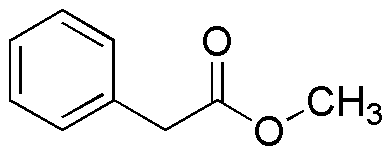Methyl phenylacetate is widely utilized in research focused on:
- Fragrance Industry: This compound is commonly used as a flavoring agent and fragrance in perfumes, providing a sweet, fruity aroma that enhances various products.
- Food Industry: It serves as a flavor enhancer in food products, contributing to the taste profile of candies, baked goods, and beverages, making them more appealing to consumers.
- Pharmaceuticals: Methyl phenylacetate is used in the synthesis of various pharmaceutical compounds, aiding in the development of effective medications with improved efficacy.
- Solvent Applications: This chemical acts as a solvent in various industrial processes, facilitating the dissolution of other substances and enhancing product formulations.
- Research and Development: It is utilized in laboratories for organic synthesis and chemical research, helping scientists explore new compounds and reactions efficiently.
General Information
Properties
Safety and Regulations
Applications
Methyl phenylacetate is widely utilized in research focused on:
- Fragrance Industry: This compound is commonly used as a flavoring agent and fragrance in perfumes, providing a sweet, fruity aroma that enhances various products.
- Food Industry: It serves as a flavor enhancer in food products, contributing to the taste profile of candies, baked goods, and beverages, making them more appealing to consumers.
- Pharmaceuticals: Methyl phenylacetate is used in the synthesis of various pharmaceutical compounds, aiding in the development of effective medications with improved efficacy.
- Solvent Applications: This chemical acts as a solvent in various industrial processes, facilitating the dissolution of other substances and enhancing product formulations.
- Research and Development: It is utilized in laboratories for organic synthesis and chemical research, helping scientists explore new compounds and reactions efficiently.
Documents
Safety Data Sheets (SDS)
The SDS provides comprehensive safety information on handling, storage, and disposal of the product.
Product Specification (PS)
The PS provides a comprehensive breakdown of the product’s properties, including chemical composition, physical state, purity, and storage requirements. It also details acceptable quality ranges and the product's intended applications.
Certificates of Analysis (COA)
Search for Certificates of Analysis (COA) by entering the products Lot Number. Lot and Batch Numbers can be found on a product’s label following the words ‘Lot’ or ‘Batch’.
*Catalog Number
*Lot Number
Certificates Of Origin (COO)
This COO confirms the country where the product was manufactured, and also details the materials and components used in it and whether it is derived from natural, synthetic, or other specific sources. This certificate may be required for customs, trade, and regulatory compliance.
*Catalog Number
*Lot Number
Safety Data Sheets (SDS)
The SDS provides comprehensive safety information on handling, storage, and disposal of the product.
DownloadProduct Specification (PS)
The PS provides a comprehensive breakdown of the product’s properties, including chemical composition, physical state, purity, and storage requirements. It also details acceptable quality ranges and the product's intended applications.
DownloadCertificates of Analysis (COA)
Search for Certificates of Analysis (COA) by entering the products Lot Number. Lot and Batch Numbers can be found on a product’s label following the words ‘Lot’ or ‘Batch’.
*Catalog Number
*Lot Number
Certificates Of Origin (COO)
This COO confirms the country where the product was manufactured, and also details the materials and components used in it and whether it is derived from natural, synthetic, or other specific sources. This certificate may be required for customs, trade, and regulatory compliance.

